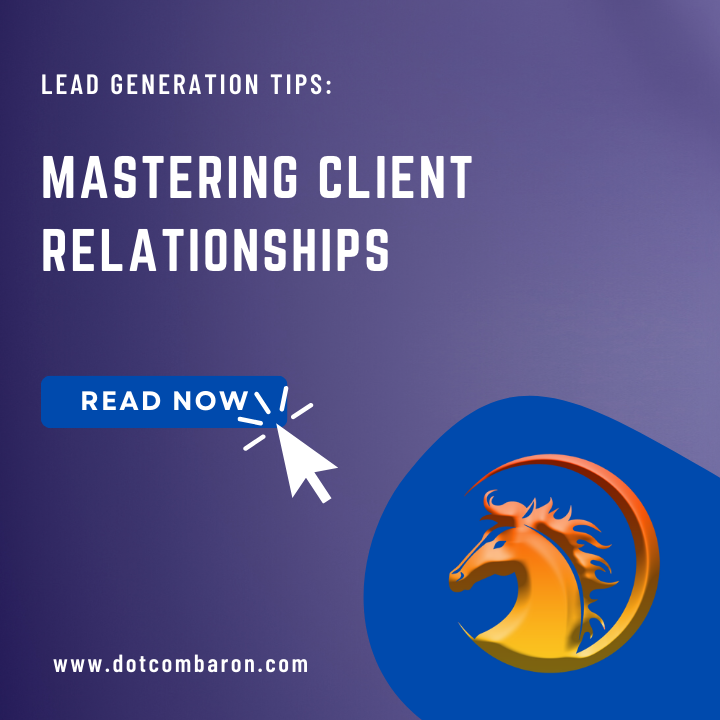Lead Generation
Mastering Client Relationships: The Ultimate Guide | DOTCOMBARON
Navigating the intricate dynamics of client relationships can often feel like a daunting task. This guide unveils the art of mastering client relationships, equipping you with strategies to foster strong, enduring collaborations.
It emphasizes the power of communication, understanding, and exceeding expectations. Discover how open-mindedness, humility, and proactivity can transform your client interactions.
Let's embark on this journey to elevate your professional success through effective client relationships.
Key Takeaways
- Effective communication is essential for building strong client relationships. This includes timely and consistent communication, clear value statements aligned with client goals, and creating an environment where clients feel comfortable sharing ideas and concerns.
- Maintaining a positive attitude is crucial in attracting and retaining clients. This involves showing enthusiasm and confidence in your work, projecting a positive image even when stressed, and demonstrating zeal and enjoyment in working with clients.
- Building personal connections with clients goes beyond treating them as paychecks. Tailoring personal connections based on industry and client type, showing genuine interest in their personal lives, and building rapport through personal connections can strengthen relationships.
- Knowledge sharing is important for building trust with clients. Educating clients about your area of expertise, explaining decisions and providing insights into your work, and fostering a sense of collaboration and involvement can make clients feel knowledgeable and valued.
The Art of Effective Communication in Client Relationships
In the realm of client relationships, mastering the art of effective communication is a pivotal factor that fosters mutual understanding, cultivates trust, and fuels collaboration towards achieving shared goals.
The power of active listening cannot be overstated; it signals to clients that their concerns and ideas are valued, thus empowering them.
Furthermore, the ability to engage in effective conflict resolution is critical, as it demonstrates professionalism and a commitment to maintaining a productive relationship.
By embracing the freedom to voice opinions and navigate disagreements, both parties can explore innovative solutions that align with their mutual interests.
Thus, these elements of communication not only enhance client interactions but also significantly contribute to the longevity and success of these relationships.
The Role of Positive Attitude in Client Service
Fostering a positive attitude within the realm of client service plays a crucial role in enhancing client satisfaction and boosting loyalty. This positivity fosters a dynamic environment where constructive feedback is welcomed, thus facilitating continuous improvement and refinement in service delivery.
- Role of Enthusiasm: An enthusiastic approach positively impacts client interactions, creating an engaging and exciting atmosphere. This enthusiasm reveals a passionate commitment to delivering results that exceed client expectations.
- Positive Attitude: A positive attitude helps in overcoming challenges, demonstrating resilience, and promoting a solutions-oriented approach.
- Building Rapport: Positive attitude aids in rapport building, making clients feel valued and understood. This helps establish long-term relationships rooted in mutual trust and respect, leading to client retention and loyalty.
Building Personal Connection: A Key to Client Satisfaction
Establishing a personal connection with clients plays a pivotal role in ensuring client satisfaction and is the cornerstone of a fruitful, long-term professional relationship. This bond transcends beyond mere business transactions, fostering a sense of mutual respect and understanding.
Building trust with clients is the first step in creating this connection. It involves consistent delivery, open communication, and a genuine interest in their needs and aspirations.
Creating rapport is equally important, requiring a conscious effort to show empathy and respect towards client perspectives. Such connections allow for the freedom of exchange, enhancing problem-solving and collaborative efforts.
Thus, a personal connection is more than just a relationship-building strategy – it is a key to client satisfaction.
Empowering Clients Through Knowledge Sharing
Why should we empower clients through knowledge sharing, and how can it enhance our professional relationships?
Knowledge sharing benefits are manifold, but primarily, they lead to empowering clients' success.
- Transparency and Trust: By openly sharing knowledge, we build a bond of trust. Clients appreciate transparency, and it paves the way for stronger collaborations.
- Client Autonomy: Knowledge sharing empowers clients to make informed decisions, fostering a sense of freedom and control.
- Mutual Growth: Sharing expertise not only helps clients but also stimulates our growth. We learn from clients' perspectives, leading to innovative solutions.
Open-Mindedness: A Fundamental Aspect of Client Relationship
Regularly demonstrating open-mindedness not only fosters innovative solutions, but also significantly strengthens the overall client relationship. This approach, integral to effective problem solving, creates a platform for mutual respect and understanding.
It encourages clients to share their perspectives freely, fostering long term collaboration. Embracing open-mindedness in problem solving helps in identifying unique, out-of-the-box solutions, tailored to meet individual client needs.
It also boosts clients' confidence in your ability to handle future challenges, thereby solidifying the relationship. Remember, clients appreciate a partner who is not restricted by traditional thinking but is receptive to new ideas.
Therefore, open-mindedness is not a mere attribute, but a fundamental aspect of mastering client relationships.
Going Beyond: How to Exceed Client Expectations
Undeniably, exceeding client expectations is a crucial strategy in building long-lasting, successful client relationships. This entails:
- Delivering Quality Work: Exceeding expectations starts with going the extra mile in providing top-tier services or products. This requires dedication, attention to detail, and a commitment to excellence.
- Exceptional Communication: Regular, transparent communication is key. This includes promptly addressing concerns, providing updates, and demonstrating an understanding of the client's needs.
- Surprising in Pleasant Ways: Whether it's delivering ahead of schedule or providing additional, unexpected value, pleasantly surprising clients can set you apart.
In essence, exceeding expectations is about delivering superior value, communicating effectively, and consistently surprising clients in positive ways. This approach fosters trust, demonstrates your commitment, and can significantly enhance client relationships.
Understanding Client Goals for a Successful Partnership
Comprehending client goals is an integral step in fostering a successful partnership and achieving mutual growth. This process involves understanding client objectives at both a macro and micro level, diving into the details of each project while considering its broader impact on their organization. This level of understanding not only builds trust but also enables you to tailor your services to meet their unique needs.
Gaining client insights into their culture and way of doing business is equally important, as it fosters a sense of mutual respect. This understanding allows for a more personalized approach, which, in turn, contributes to a successful partnership.
Adapting Communication Style to Client Preferences
A client's communication preference is a critical aspect to consider, and adjusting your style to match theirs can greatly enhance the working relationship. Adapting communication style is an art that requires understanding and empathy.
- Understand their communication preference: Some clients prefer concise emails, while others may favor detailed discussions over the phone or face-to-face meetings.
- Match their communication pace: If your client prefers quick, rapid-fire communication, adapt accordingly. Conversely, if they favor a more deliberate pace, slow down.
- Respect their preferred communication times: Some clients may prefer communication during business hours, while others might be more responsive during the evenings.
The Importance of Staying Humble in Professional Relationships
While many professionals may excel in their fields, it is essential to remember that humility, combined with a sincere respect for the client's knowledge and experience, can greatly enhance a professional relationship. The benefits of humility in professional relationships are profound, fostering a sense of collaboration and mutual respect.
By acknowledging the client's expertise, we not only empower them but also position ourselves as partners in their success. Humility paves the way for open, honest communication, encouraging the free exchange of ideas. Furthermore, developing trust through humility is instrumental in building sustainable, long-term relationships.
When we approach our clients with humility, we demonstrate our commitment to their goals, thus ensuring their freedom to express their needs and expectations.
Frequently Asked Questions
How Can You Effectively Manage a Client Who Has Unreasonable Demands?
To manage a client with unreasonable demands, employ communication techniques to express your concerns, emphasizing the feasibility of their requests. Set boundaries to establish realistic expectations, balancing their desires with the project's practical execution.
How Should You Handle a Situation Where a Client Is Unhappy With the Results?
In situations where a client is unhappy with the results, it's essential to deploy damage control strategies and emotion management techniques. This involves active listening, empathy, proactive problem-solving, and ensuring client satisfaction.
What Strategies Can You Use to Balance Multiple Client Relationships Effectively?
Balancing multiple client relationships effectively involves prioritizing clients based on their needs and implementing time management techniques. Through clear communication, proactive problem-solving, and understanding client goals, robust, long-term relationships can be cultivated and maintained.
How Do You Approach a Client Who Lacks Understanding or Appreciation of Your Area of Expertise?
To approach a client lacking understanding in your expertise, implement client education strategies. Clearly articulate your knowledge, using language they understand. This facilitates Expertise Communication, encourages trust, and fosters a more productive, collaborative relationship.
What Are the Best Practices for Dealing With Conflicts or Disagreements in a Client Relationship?
"As the saying goes, "Rome wasn't built in a day." Similarly, conflict resolution demands patience. Utilizing assertive communication, openly discuss disagreements, encouraging mutual understanding, fostering a client-oriented environment that embodies the spirit of freedom and collaboration."
Conclusion
Conclusively, cultivating client connections calls for clear communication, cheerfulness, and a capacity for change. Sharing skills, surpassing expectations, and securing an understanding of client goals significantly strengthens service.
Adapting articulation aligns with audience inclinations, amplifying appreciation. Humility heightens professional harmony. Persistently practicing these principles promises prosperous partnerships, providing a pathway to peak business performance.
This guide gives a glimpse into gaining and guarding valued client relationships, a crucial cornerstone for commercial success.





